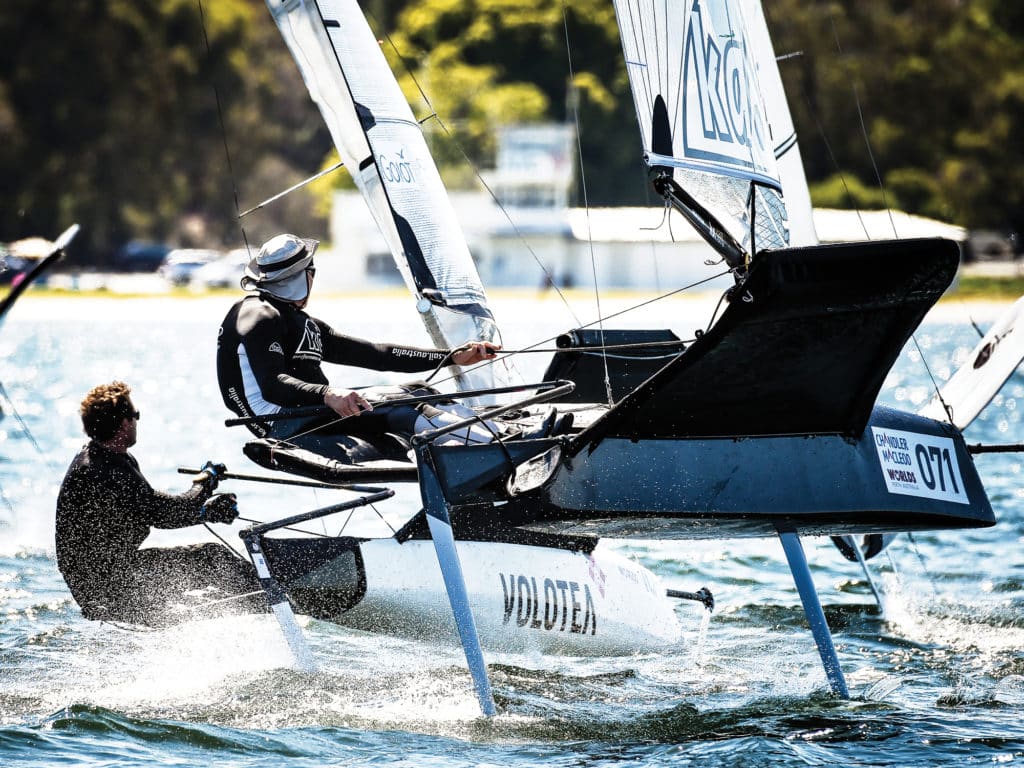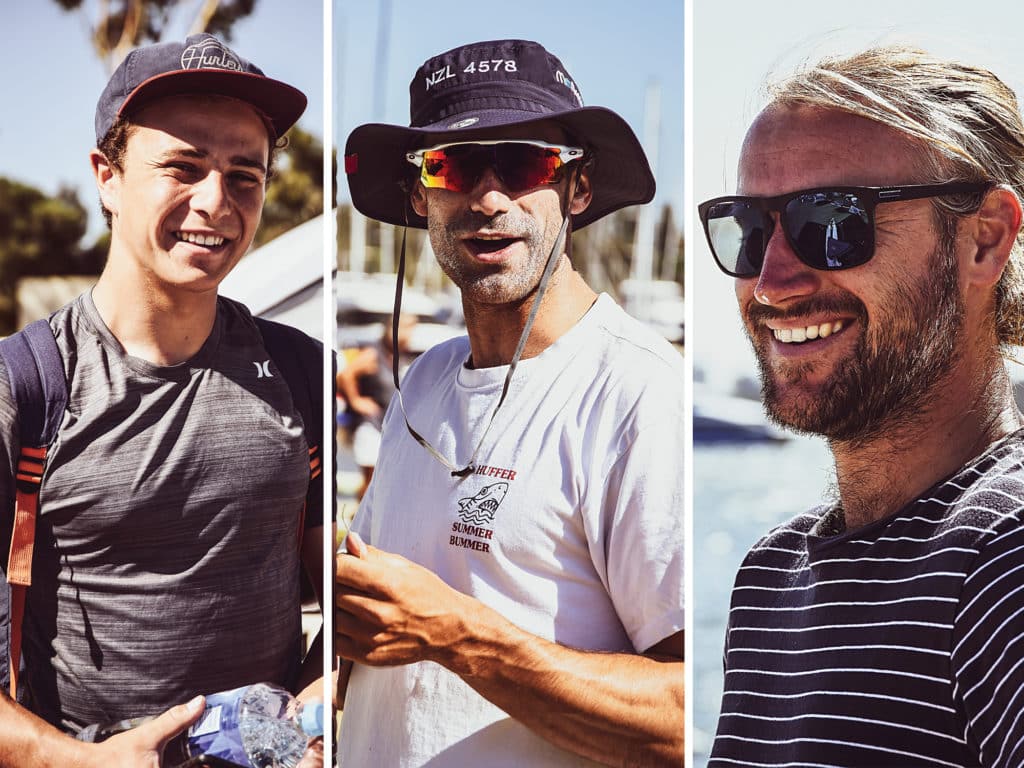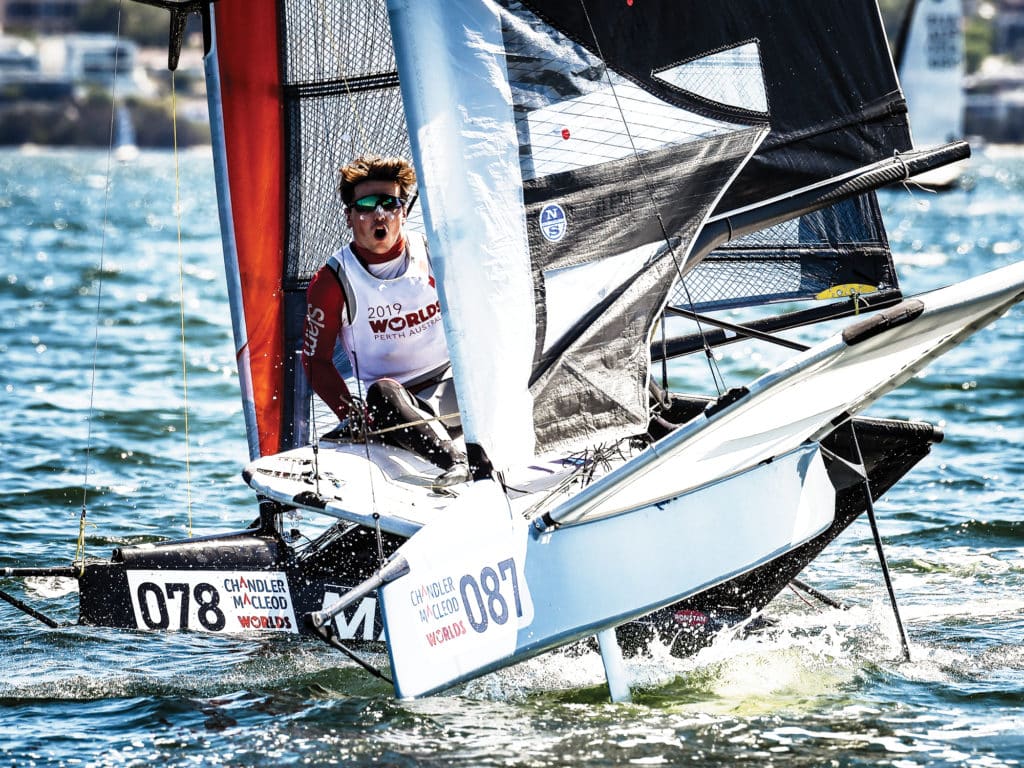
There is an eye-opening video clip posted online from the last day of the 2019 Moth Worlds in Perth, Australia. The drone follows Tom Slingsby as he tears across the finish line, winning the whole enchilada with two races to spare. In a class now populated with high-net, young professional sailors, to win 12 straight races is mind-blowing alone, but the most incredible part of this visual is the outrageous speed. Slingsby’s foils are just shy of perching the surface; there’s minuscule drag, there’s a slight twitch on the helm, and his go-for-it hiking posture is inspiring. In 20-plus knots of breeze, Slingsby, in this moment, and the entire week, is redlining his torpedo-shaped Exocet Moth. Talk about sending it.
This is a big deal. Slingsby and the rest of the top 10 at the worlds were doing nearly 20 knots upwind, a 2-knot difference from a year earlier. Downwind, they’re pushing 30. It’s hard to imagine so much progression can come out of such a small package, but the Moth—which has influenced modern foiling, from the America’s Cup to the little productions Skeeta and UFO, and even windfoiling—is still the highest-profile foiler on the planet. This, despite being crazy expensive at $30,000 for a new boat.

This is also a big deal because the class continues to push the high-performance fringe of the sport, from foil technology and design to sailing techniques. Incremental changes that have added up to the gains Slingsby and his buddies demonstrate have come from deck-sweeping sails, “aero packages” that reduce wind drag, and ever-shrinking foil shapes.
But let’s be real. Who can actually do what gold medalist and Cup winner Slingsby does? Very few. First, the cost of a new—or even a good used boat—is ridiculous. And the time commitment? From my two years of Moth sailing, I know the investment in time on the water alone. Simply learning how to jibe (for me, more than 21 sessions of extended lunch breaks and evening sessions) is impossible for most working folk. And don’t even mention the amount of time it takes to set up, tweak, and repair these intricate and delicate carbon machines.
Despite all these barriers, however, the class continues to grow internationally, with 122 competitors signing on to be part of Slingsby’s Southern Hemisphere Slaying. There are rank-and-file American sailors who have accepted that racing a Moth is worth every penny and minute they can muster to get around the racecourse. It’s just super-addictive, and yes, where there’s a will there’s a way to do it at your own pace and within your own budget.
Dan Flanigan, one of the few Americans to compete in the Perth Worlds, says, “If you sail once a month, it will take five years to get around the course.” He was 79th of 122 —and pumped with his finish.
Flanigan, 28, is an engineer and recently started his own engineering, design and build company called Kroova, in San Diego. He kept an educational and witty log of his first worlds experience in Australia. It was classic Mothie: “I had some control issues (read: multiple pitch poles and crashes)…I told my fiancé I was currently 32 out of 60 in the Silver Fleet, and from 34th on, it was DNFs and UFDs. ‘What a weird class,’ she said. I couldn’t agree more!”
Flanigan’s self-deprecating tone is common language in a scene where the learning curve is so steep, so demoralizing, that to simply survive the process is a badge of honor. It’s entry into a community that knows the regular feeling of dopamine releases while screaming along on every downwind leg. Flanigan knew he was progressing when he reported he was 30th of 60—but remember, the DNFs started at 47.
Progression is a big buzzword in Moth sailing. It’s challenging to simply trim in the sail and get underway, then there’s perfecting your turns, there’s knowing your controls and shifting through those gears rapidly into and out of a tack.
“It was functionally too early for my first worlds,” says Flanigan, who since this past winter has been practicing after work and on weekends with 10 or so Moth sailors in San Diego. “For most people at their first worlds, the minimum sailing time has been two years. If I could let go of the feeling of being beat, I would improve quicker than the guys around me.”
Such an attitude allows him to keep an eye on the prize: progression.
Progression is a big buzzword in Moth sailing. It’s challenging to simply trim in the sail and get underway, then there’s perfecting your turns, there’s knowing your controls and shifting through those gears rapidly into and out of a tack, which, by the way, is the Holy Grail for those in the middle to bottom half of the fleet. “Once you get your first foiling tacks,” Flanigan says, “it’s a huge drug, a chemical reaction that happens inside you.”
About half of the silver fleet at the worlds had the “ability” to foil tack. Moth sailing is an endless progression, and Flanigan and others simply enjoy stumbling down the rocky path. “It’s easy to say, ‘Don’t focus on the results,’ but it’s hard to feel that. With the time you spend, you want to do well,” Flanigan says.
When he had a good race, he would round a mark with a whole new group of competitors. “I thought, This is a massive improvement. I made five foiling tacks the whole regatta, but it was huge gains.”
Flanigan’s goal, of course, is to “learn the boat as fast as possible, with having a job, a functional relationship—while being completely obsessed—and sail the boat as fast as possible.” He hopes five years of this approach will give him the skills to compete at the worlds each year, the rewards, he says, of hard work and commitment to fitness.

But Flanigan is not there yet. He’s on the steep end of the curve. His professional skills, though, make him a keen observer of the progression at the top of the worlds fleet. “Aero is getting more and more important as apparent windspeed gets above 30 knots upwind,” he says. Flanigan is using a Mach2, upgraded with the ubiquitous bow sprit that holds the wand out farther for steadier ride-height control in choppy conditions. The Mach 2.5 has no compression struts at the mast step, allowing deck-sweeping sails to take a more refined shape. Wing bars are now flared down at the back side to line up better with apparent wind while sailing upwind. “They’re playing with lift and righting moment,” he says, referring to the leeward wing bar lifting and the weather wing bar pulling down.
Although Slingsby and others in the top 20 raced their Exocet Moths, from Britain, and the once-dominant Mach2 is regularly in the hunt for titles, there are more new designs than ever, allowing for fine-tuning to the sailor’s weight and strength. Matt Chew, of Australia, was eighth in a Paul Bieker-designed Moth. Bieker is an innovator who has created a flush-deck Moth that has so little area for its width, many say it looks way too long to be class legal. There’s a lot less aero drag, but the new deck-sweeper sail also has no impediments such as a raised forward deck to get in the way of a perfectly fair shape. The Bieker’s flat top helps advance the deck-sweeping concept. The effect of the new sail design is twofold: The end-plate effect reduces drag; and the lower center of effort allows for increased drive force for the same righting moment.
Because the boats are going faster, the foil shapes are changing too. Luka Damic has quickly dominated in this space with his Swift Foils, which were on the majority of the top 10. The chord lengths on the vertical foils are shorter and, especially where they meet the horizontal element, are much thinner. When you see Slingsby riding ridiculously high, he is trying to get every millimeter of his vertical appendage out of the water—to reduce drag. When you’re going 30-plus knots, a few less millimeters of vertical foil in the water is a big reduction in hydrodynamic drag.
The breeding pool for American Moth sailors has been small and continues to be a moving target. Two winter series, one in Southern California and one in the Florida Keys, are really the only gatherings where racing Moths is a “thing.” But these and other pockets of Moths might be breeding something even better: stoked sailors.
“Personally, I had lost the joy in sailing,” says Helena Scutt, an Olympian who stopped a Nacra 17 campaign last year and then decided to focus on her engineering career. “Last year I started a journey with the Moth to put the fun back in sailing. I never want to lose that again.”
Scutt purchased an Exocet during her campaign, believing her foiling skills would translate to Nacra sailing. The campaign is over, and now she’s trying to get better in the Moth in the San Francisco Bay area. She’s an Olympic-caliber athlete, but even Scutt is on the same learning curve as every Moth sailor. “I’ve been knocked down so many times,” she says, “but I come out of the water with a grin and say, ‘That was an awesome wipeout.’”
Scutt, who is also the US Moth Class president, finished eighth overall in September’s North American Championship in San Diego. She is progressing nicely up the curve. “It was my first real Moth regatta,” she says. “I’m just analyzing where the gains and losses are. Boathandling is low-hanging fruit.”

The Waszp is essentially a production version of the Moth, and groups in the United States have had an easier time attracting females to the fold. Scutt points to a few Moth-specific challenges that favor the Waszp for some sailors. “The expense is a factor,” Scutt says, adding that a lot of other boats are cheaper than a Moth and “almost as much fun.” Experience in high-performance boats, like skiffs, is helpful in foiling but not prevalent among female sailors. Scutt says this has nothing to do with “capability.” It’s a matter of exposure. And being an equipment-based development class also doesn’t play into the current skills of female sailors. She adds that these factors are historical and that Moth sailing “exaggerates these factors.”
Scutt encourages all Moth sailors to reflect on the opportunities that got them into the class, and then spend a little time exposing new sailors, especially women, to the Moth. “Share your knowledge, give them a chance to try it and get hooked.”
Still, Scutt says the Moth is the tip of the spear in performance sailing. “The Moth came out of sailing; now foiling is more ubiquitous,” she says. “When I think of sailing and foiling, it’s a pretty cool time to be around and flying. A couple of years ago, we never would have imagined this.”
Moths are surely the most expensive bit of singlehanded monohull sailing kit you can own, though the price of recreational foilers is getting more reasonable. But in Mission Bay and Key Largo each winter, there will be 20 or 30 Moth sailors of every ability ripping around, tuning up, and helping one another tweak a gearing mechanism for the wand or repair a push rod on their main foil flap. Some will try to play with the likes of Slingsby, while others will simply enjoy their progression.
Flanigan’s last few posts from the worlds speak to the average Moth sailor’s attitude. “Missed tack, flipped at top mark…. When I say I have ‘good pace upwind,’ I understand fully that it is relative only to the bottom half of the fleet.” With his best race in the silver fleet being a seventh of 61 (DNFs starting from 36th), his closing comment is, “This was an awesome event.”
Slingsby, of course, would agree.









